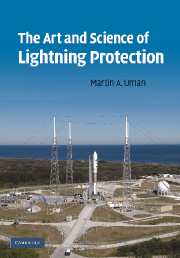Book contents
- Frontmatter
- Contents
- Preface
- 1 What is lightning?
- 2 Lightning damage
- 3 General methods for lightning protection: Faraday cages, topological shields; and more practical approaches: cone of protection and rolling sphere methods
- 4 Structure protection: air terminals and down conductors
- 5 Structure protection: grounding
- 6 Surge protection for electronics in low-voltage electrical systems
- 7 Humans and animals
- 8 Lightning warning
- 9 Airships, airplanes, and launch vehicles
- 10 Ships and boats
- 11 Trees
- 12 Overhead and underground power and communication lines
- 13 Lightning elimination
- 14 So, what do we know and what don't we know about lightning protection?
- Index
- References
6 - Surge protection for electronics in low-voltage electrical systems
Published online by Cambridge University Press: 17 November 2009
- Frontmatter
- Contents
- Preface
- 1 What is lightning?
- 2 Lightning damage
- 3 General methods for lightning protection: Faraday cages, topological shields; and more practical approaches: cone of protection and rolling sphere methods
- 4 Structure protection: air terminals and down conductors
- 5 Structure protection: grounding
- 6 Surge protection for electronics in low-voltage electrical systems
- 7 Humans and animals
- 8 Lightning warning
- 9 Airships, airplanes, and launch vehicles
- 10 Ships and boats
- 11 Trees
- 12 Overhead and underground power and communication lines
- 13 Lightning elimination
- 14 So, what do we know and what don't we know about lightning protection?
- Index
- References
Summary
Overview
As noted in Section 1.4 and Section 3.2, it is common to consider separately (1) the lightning protection of a structure and (2) the lightning protection of the electrical power, electronic equipment (e.g., television, DVD, burglar alarm system, computer), and communication systems (e.g., telephone, cable television) located within that structure, although, as we have discussed in Section 3.1, it is preferable to consider the two aspects of protection in a unified way as part of an overall topologically shielded and surge-protected system. The electrical power, electronic equipment, and communication systems within a structure are generally connected to the outside world by conducting wires, primarily 50 Hz or 60 Hz utility power wiring and telephone cables. Outside metallic wires are exposed to direct lightning strikes and suffer significant induced voltages and currents due to lightning occurring with a few hundred meters of those wires. In this chapter we consider primarily the protection of low-voltage systems. By “low voltage” we mean any voltage equal to or below the normal household power level, 480 volts generally being the highest “low voltage” satisfying this definition. In Section 12.2 we will examine the use of surge arresters on distribution and transmission power lines where the voltages may vary from some thousands of volts on distribution lines to about a million volts on transmission lines.
Surge protective devices (SPDs) are known by a number of different names including “arresters,” “surge arresters,” and “lightning arresters.”
- Type
- Chapter
- Information
- The Art and Science of Lightning Protection , pp. 99 - 110Publisher: Cambridge University PressPrint publication year: 2008



